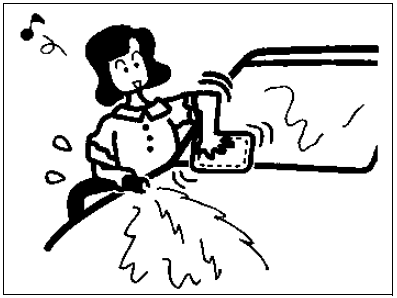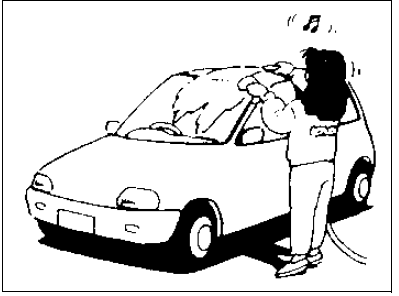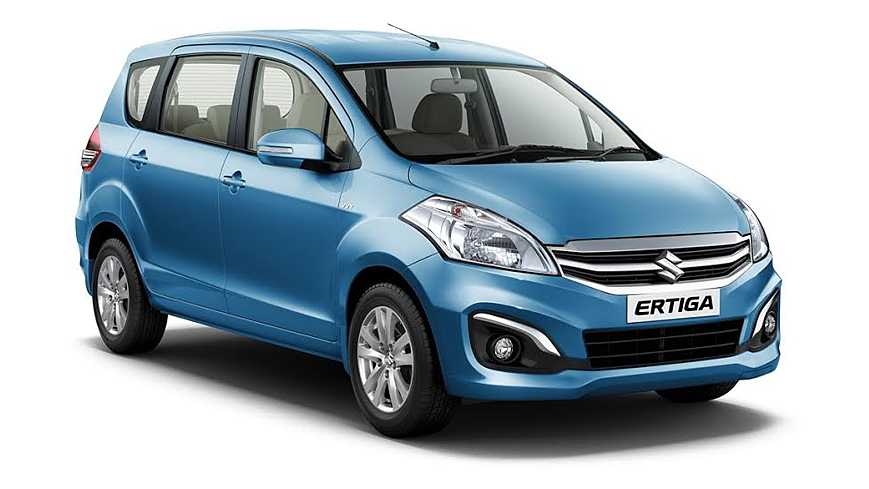Suzuki New 2018 AERTIG APPEARANCE CARE User Manual
APPEARANCE CARE
Corrosion Prevention
It is important to take good care of your vehicle to protect it from corrosion. Listed below are instructions for how to maintain your vehicle to prevent corrosion. Please read and follow these instructions carefully.
Important Information about Corrosion
- Accumulation of road salt, dirt, moisture, or chemicals in hard-to-reach areas of the vehicle underbody or frame.
- Chipping, scratches and any damage to treated or painted metal surfaces resulting from minor accidents or abrasion by stones and gravel.
Environmental conditions which accelerate corrosion
- Road salt, dust control chemicals, sea breeze or industrial pollution will all accelerate the corrosion of metal.
- High humidity will increase the rate of corrosion particularly when the temperature range is just above the freezing point.
- Moisture in certain areas of a vehicle for an extended period of time may pro-mote corrosion even though other body sections may be completely dry.
High temperatures will cause an accelerated rate of corrosion to parts of the vehicle which are not well-ventilated to permit quick drying.
This information illustrates the necessity of keeping your vehicle (particularly the underbody) as clean and dry as possible. It is equally important to repair any damage to the paint or protective coatings as soon as possible.
How to Help Prevent Corrosion
Wash your vehicle frequently
The best way to preserve the finish on your vehicle and to help avoid corrosion is to keep it clean with frequent washing. Wash your vehicle at least once during the winter and Wash your vehicle frequently once immediately after the win-ter. Keep your vehicle, particularly the underside, as clean and dry as possible. If you frequently drive on salted roads, your vehicle should be washed at least once a month during the winter. If you live near the ocean, your vehicle should be washed at least once a month throughout the year.
For washing instructions, refer to “Vehicle Cleaning” section.
Repair finish damage
Carefully examine your vehicle for damage to the painted surfaces. Should you find any chips or scratches in the paint, touch them up immediately to prevent corrosion from starting. If the chips or scratches have gone through to the bare metal, have a qualified body shop make the repair.
Keep passenger and luggage compartments clean
Moisture, dirt or mud can accumulate under the floor mats and may cause corrosion. Occasionally, check under these mats to ensure that this area is clean and dry. More frequent checks are necessary if the vehicle is used for off-road driving or in wet weather.
Certain cargos such as chemicals, fertilizers, cleaners, salts, etc. are extremely corrosive by nature. These products should be transported in sealed containers. If they are spilled or leaked, clean and dry the area immediately.
Park your vehicle in a dry, well-ventilated area
Do not park your vehicle in a damp, poorly ventilated area. If you often wash your vehicle in the garage and place it there in wet condition, your garage may be damp. The high humidity in the garage may cause or accelerate corrosion. A wet vehicle may corrode even in a heated garage if the ventilation is poor.
WARNING
Do not apply additional undercoating or rust preventive coating on or around exhaust system components such as the catalytic converter, exhaust pipes, etc. A fire could be started if the undercoating substance becomes overheated.
Vehicle Cleaning
WARNING
When cleaning the interior or exterior of the vehicle, do not use flammable solvents such as lacquer thinners, gasoline and benzene. Also, do not use cleaning materials such as bleaches and strong household detergents. The materials could cause personal injury or damage to the vehicle.
Cleaning Interior
Leather upholstery
Remove loose dirt with a vacuum cleaner. Using a mild soap or saddle soap solution, wipe dirt off with a clean damp soft cloth. To remove soap, wipe the areas again with a soft cloth dampened with water. Wipe the areas dry with a soft dry cloth. Repeat this until the dirt or stain is removed, or use a commercial leather cleaner for tougher dirt or stains. If you use a leather cleaner, carefully follow the manufacturer’s instructions and precautions. Do not use solvent type cleaners or abrasive cleaners.
NOTE:
- In order to keep leather upholstery looking good, it should be cleaned at least twice a year.
- If leather upholstery becomes wet, immediately wipe it dry with tissue paper or a soft cloth. Water may cause leather to harden and shrink if it is not wiped off.
- When parking on sunny days, select a shady place or use a sunshade. If leather upholstery is exposed to direct sunlight for a long time, it may discolor and shrink.
As is common with natural materials, leather is inherently irregular in grain and cowhide has spots in its natural state. These do not affect the performance of the leather in any way.
Vinyl upholstery
Prepare a solution of soap or mild deter-gent mixed with warm water. Apply the solution to the vinyl with a sponge or soft cloth and let it soak for a few minutes to loosen dirt.
Rub the surface with a clean, damp cloth to remove dirt and the soap solution. If some dirt still remains on the surface, repeat this procedure.
Fabric upholstery
Remove loose dirt with a vacuum cleaner. Using a mild soap solution, rub stained areas with a clean damp cloth. To remove soap, rub the areas again with a cloth dampened with water. Repeat this until the stain is removed, or use a commercial fabric cleaner for tougher stains. If you use a fabric cleaner, carefully follow the manufacturer’s instructions and precautions.
Seat belts
Clean seat belts with a mild soap and water. Do not use bleach or dye on the belts. They may weaken the fabric in the belts.
Vinyl floor mats
Ordinary dirt can be removed from vinyl with water or mild soap. Use a brush to help loosen dirt. After the dirt is loosened, rinse the mat thoroughly with water and dry it in the shade.
Carpets
Remove dirt and soil as much as possible with a vacuum cleaner. Using a mild soap solution, rub stained areas with a clean damp cloth. To remove soap, rub the areas again with a cloth dampened with water. Repeat this until the stain is removed, or use a commercial carpet cleaner for tougher stains. If you use a carpet cleaner, carefully follow the manufacturer’s instructions and precautions.
Instrument panel and console Remove
loose dirt with a vacuum cleaner. Gently wipe dirt off with a tightly squeezed damp clean cloth. Repeat this until the dirt is removed.
NOTICE
Do not use chemical products that contain silicon to wipe electrical components such as the air conditioning system, audio, navigation system, or other switches. These will cause damage to the components.
NOTICE
Liquid such as liquid aromatics, soft drinks or juice may cause dis-coloration, wrinkles, and cracking to resin-based parts and textiles. Immediately wipe it dry with tissue paper or a soft cloth.
Do not leave leather products with color, fur or vinyl products, etc. in your vehicle for long periods. It may cause discoloration or deterioration of interior.
Cleaning Exterior
NOTICE
It is important that your vehicle be kept clean and free from dirt. Failure to keep your vehicle clean may result in fading of the paint or corrosion to various parts of the vehicle body.
Caring for Aluminum Wheels NOTE:
Do not use an acidic or alkaline detergent, or a cleaner containing petroleum solvent to wash aluminum wheels. These types of cleaner will cause permanent spots, discoloration and cracks on finished surfaces and damage to center caps. Do not use a bristle brush and soap containing an abrasive material. These will damage finished surfaces.
Washing
WARNING
- Never attempt to wash and wax your vehicle with the engine running.
When cleaning the underside of the body and fender, where there may be sharp-edged parts, wear gloves and a long-sleeved shirt to protect your hands and arms from being cut. - After washing your vehicle, care-fully test the brakes before driving to make sure they have maintained their normal effectiveness.
- Washing by hand

When washing the vehicle, park it in the place where direct sunlight does not fall on it as much as possible and follow the instructions below:
- Flush the underside of body and wheel housings with pressurized water to remove mud and debris. Use plenty of water.
NOTICE- Avoid directing steam or hot water of more than 80°C (176°F) on plastic parts.
- To avoid damaging engine components, do not use pressurized water in the engine compartment.
- Rinse the body to loosen the dirt.
Remove dirt and mud from the body exterior with running water. You may use a soft sponge or brush. Do not use hard materials which can scratch the paint or plastic. Remember that the headlight covers or lenses are made of plastic in many cases.
NOTICE
To avoid damage to the paint or plastic surface, do not wipe the dirt off without ample water. Follow the above procedure. - Wash the entire exterior with a mild detergent or car wash soap using a sponge or soft cloth. The sponge or cloth should be frequently soaked in the soap solution.
NOTICE
When using a commercial car wash product, observe the cautions specified by the manufacturer. Never use strong household detergents or soaps. - Once the dirt has been completely removed, rinse off the detergent with running water.
- Wipe off the vehicle body with a wet chamois or cloth and allow it to dry in the shade.
- Check carefully for damage to painted surfaces. If there is any damage, touch up the damage following the procedure below:
- Clean all damaged spots and allow them to dry.
- Stir the paint and touch up the dam-aged spots lightly using a small brush.
- Allow the paint to dry completely.
Washing by an automatic car wash
NOTICE
If you use an automatic car wash, make sure that your vehicle’s body parts, such as an antenna, cannot be damaged. If you are in doubt, consult the car wash operator for advice.
Washing by a high-pressure cleaner
NOTICE
If you use a high-pressure cleaner, keep away the nozzle from your vehicle sufficiently.
- Bringing the nozzle to your vehicle too close or pointing the nozzle to the opening of front grill or bumper etc. can cause damage and mal-function of the vehicle body and parts.
- Pointing the nozzle to door glasses and door frames can allow water to enter the cabin.
Waxing
After washing the vehicle, waxing and polishing are recommended to further protect and beautify the paint.
Only use waxes and polishes of good quality.
When using waxes and polishes, observe the precautions specified by the manufacturers.
-
Reference Links
View Full User Guide: Suzuki New ERTIGA 2018 User Manual
Download Manuals: https://suzuki-aftersales.net/manuals


